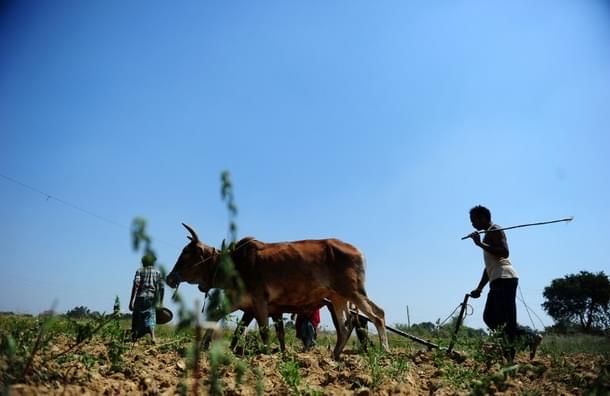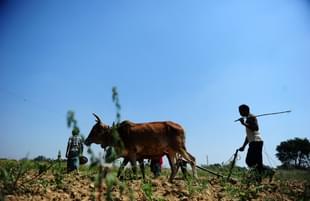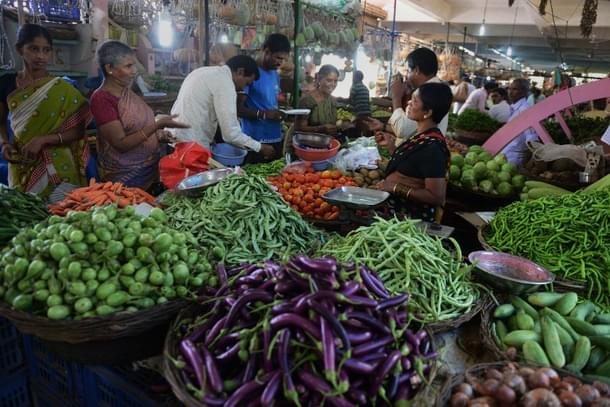Economy
Four Issues Causing Agri-Distress That We Must Be Discussing
Seetha
May 05, 2015, 12:00 PM | Updated Feb 11, 2016, 09:24 AM IST
Save & read from anywhere!
Bookmark stories for easy access on any device or the Swarajya app.


Massive spending on subsidies instead of infrastructure, higher short-term credit than long term loans, lack of a smart subsidy regime and uneconomical farm sizes are destroying Indian agriculture.
Sharad Joshi, founder of Shetkari Sanghatan and the Swatantra Bharat Paksh, wants a Marshall Plan for agriculture. “The situation of farmers is precarious; callous government policies and the vagaries of nature have combined to make it so bad,” he says. (Marshall Plan was the popular name for the European Recovery Programme which saw the United States pumping in $13 billion to help European economic recovery in the post-war years.)
Joshi does not hold any one government responsible for the mess in agriculture. The pre-1947 imperial exploitation, he says, has only been replaced by post-1947 socialist exploitation, which did not end with the 1991 economic reforms. Other agricultural economists, more to the left of the ideological spectrum, like Abhijit Sen, former Planning Commission member, and S. Mahendra Dev, director of the Indira Gandhi Institute of Development Research (IGIDR), feel agriculture has got a short shrift post-1991. But everyone is agreed on one point – that the farmers’ inability (or lack of it) to deal with shocks like the recent unseasonal rains playing havoc with crops is the accumulated result of years of neglect of agriculture and bad agricultural policy.
“But farmers have never been able to cope,” counters Sudha Narayanan, assistant professor at the IGIDR. Suicides by farmers, she notes, is not a recent phenomenon; it is just that it never got picked up by the media. Data was also not available for the media to pick up. The National Crime Records Bureau started disaggregating suicide data by profession only from 1995.

There’s a whole gamut of issues plaguing the sector: fragmented size of holdings, over-dependence on rainfall and lack of irrigation, excessive controls, lack of infrastructure. Instead of chasing quick-fix and populist solutions, under political pressure, it might be better for the National Democratic Alliance government to start addressing these structural issues.
But first, a quick look at why the noise over farmers’ suicides appears more high-pitched today – when they have been declining since 2009 – than in 2004 when suicides touched 18,241, capping a rising trend since 1997.
Sen points out that from 2004-05 till about 2011-12, farmers had it “fairly ok.” There were no major farm-related issues and the terms of trade were moving in favour of agriculture. This is borne out by a report of a working group headed by Dev set up to recommend a new methodology of calculating term of trade for agriculture. The report notes that the index of the terms of trade for farmers increased from 87.82 in 2004-05 to 102.95 in 2010-11. The reasons: mainly increase in minimum support prices (MSP) and rising global agricultural prices.
After 2010-11, however, the terms of trade started declining and came down to 95 in 2013-14. Global prices started cooling off, MSP hikes for rice and wheat were moderated (the moderation started during the United Progressive Alliance time) and there were steep increases in wages and prices of diesel, fertilisers and other inputs. The unseasonal rains aggravated matters.
1. Massive Public Spending On Subsidies Instead of Infrastructure
So, does that mean things were actually better for farmers during the UPA years? To be fair, yes, there was an increase in public investment in absolute terms during this period. The share of actual expenditure on agriculture and allied activities in total expenditure increased from 3.8 per cent in the Tenth Plan (2002-07) to 4.4 per cent in the Eleventh Plan (2007-12). The expenditure in the Eleventh Plan period also exceeded the Plan outlay on agriculture, which was 3.7 per cent of total outlay (a dip from 3.9 per cent in the Tenth Plan). The share of outlay on agriculture in the Twelfth Plan (2012-17) was projected at 4.7 per cent. Agricultural economist Ashok Gulati acknowledged in 2012 that government spending on agriculture – almost 20-25 per cent of agricultural GDP – was among the highest in south and southeast Asia.
Unfortunately, he pointed out, close to 80 per cent of this spending was on input subsidies on fertiliser, electricity and irrigation. The Pocket Book of Agricultural Statistics 2014 shows that while gross capital formation (GCF) in agriculture did show a rising trend from 2004-05 to 2012-13, from 13.5 per cent in agricultural GDP to 16.9 per cent, the bulk of this increase was in the private sector (10.6 per cent to 14.1 per cent). GCF in the public sector stagnated at around 2.9 per cent. The Modi government should work to set this skew right; increased government spending on infrastructure – rural roads, irrigation, electricity, cold chains and the like – is vital.
2. More Credit But Much Of Them Short-Term
On agricultural credit, too, the UPA does deserve some kudos. Soon after coming to power, the Manmohan Singh government made announcements about raising agricultural credit by 30 per cent a year and financing 100 farmers per bank branch, among other things. Ministry of Agriculture data shows that not only did the target set for rural credit increase steadily from 2004-05 (Rs 10,500 crore) to 2012-13 (Rs 575,000 crore), the achievement significantly exceeded the target every year.
A study on Bank Credit to Agriculture in India in the 2000s: Dissecting the Revival by R. Ramakumar and Pallavi Chavan of the Tata Institute of Social Sciences (TISS) notes that while 922 rural bank branches were closed down between 1995 and 2005, 5710 new rural bank branches were opened between 2005 and 2012. This was accompanied by an increase in credit flow to agriculture.

Time for a reality check, though. The TISS study goes beyond the aggregate numbers and shows that the share of agricultural credit from branches in rural and semi-urban areas declined steadily between 1995 and 2011, while the share from branches in urban and metropolitan areas increased. Tables in the study show that in 1995, rural branches accounted for 51.7 per cent of total agricultural credit, semi-urban 29.3 per cent, urban and metropolitan 9.5 per cent each. By 2011, the share of rural and semi-urban branches had come down to 37.9 per cent and 29 per cent respectively while that of urban and metropolitan branches had increased to 18.4 per cent and 14.7 per cent respectively.
The study also shows disconnect between agricultural credit and investment in fixed capital. Between 1991-92 and 2011-12, it notes, the share of long-term credit (used to finance capital investment) in direct agricultural credit fell from 75 per cent to 39.3 per cent. On the other hand, the share of short-term credit (crop loans and for seasonal operations) increased from 24.9 per cent to 60.7 per cent over the same period. Narayanan says it is important to invest in farm-level infrastructure like micro-level irrigation structures to reduce dependence on rainfall.
So, clearly, beyond the grand announcements and claims, there are details that need to be studied and course correction done, if required.
3. Uneconomical Farm Sizes
It is well-acknowledged that uneconomical farm sizes are hampering Indian agriculture. Over 80 per cent of land holdings are of less than two hectares in size; just about 5 per cent are more than four hectares in size. This, says Narayanan, is a legacy of our land ceiling laws, which did not allow farmers to consolidate land holdings as was done in the west. One way out could be for farmers to rent out their land for large agricultural operations. But, she points out, this is a risky proposition right now. “Unless you have land titling and enforcement of titles and contracts, farmers will not be comfortable with renting out land.”
Narayanan also laments the distortions in marketing information and infrastructure and roots for an integrated national market. “Fragmented markets keep crises localised but they also hamper solutions in another problem-stricken area,” she points out. But attempts to reform agricultural markets have not met with much success; there is far too much politics involved, says Dev.
4. Lack of A Smart Subsidy Regime
The subsidy regime also needs an overhaul. Right now, the fertiliser subsidy policy is only leading to soil deterioration, given the over-use of urea because of low prices (which is also leading to black marketing of urea, everyone acknowledges). This will have to be phased out in a manner that protects the small and marginal farmer, says Dev.
Could the subsidy skew be tilted towards crop insurance? That is the international experience and it is time that the government looked at crop insurance seriously. Sen warns that it is much more difficult than most people realise and that the moral hazards are high, but that a way will have to be found.
Unfortunately, one does not hear of these issues being discussed in all the noise over farmers’ suicides in Parliament. None of these are quick-fix or populist solutions but they are needed to put Indian agriculture on a sound footing. Will these completely de-risk agriculture? Perhaps not. But farmers may not be faced with as bleak a future as they now are.
Seetha is a senior journalist and author





